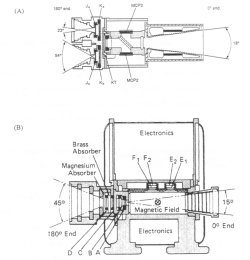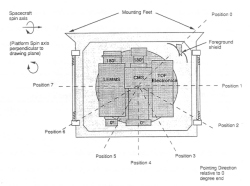Investigation of the Magnetosphere of Ganymede with Galileo's Energetic Particle Detector
Ph.D. dissertation by Shawn M. Stone, University of Kansas,
1999.
Copyright 1999 by Shawn M. Stone. Used with permission.
3.1 The EPD Instrument
The EPD instrument is designed to measure the composition, intensities, energies, and angular distribution of charged particles over a large range of the Jovian magnetosphere, between 6 Rj <= R <= 225 Rj. It uses two bi-directional silicon solid-state detector systems: the Low Energy Magnetospheric Measurement System (LEMMS) and the Composition Measurement System (CMS). A schematic representation of both detectors is shown in Figure 3.2. Only the LEMMS detector needs detailed mention for this study.
 |
Figure 3.2 (A) The CMS detector of the EPD instrument. It is designed to measure the composition of ions in the Jovian environment from energies of >=10 keV/nucl to >10 MeV/nucl. (B) The LEMMS detector of the EPD instrument. It is designed to measure electrons from 15 keV to >11 MeV and ions from 22 keV to 55 MeV [Williams et al., 1992]. |
These two detectors are mounted on a platform that is rotated by a stepper motor into eight positions, as shown in Figure 3.3. Step motor position 0 lies behind a foreground shield/source holder for background measurements and in-flight calibrations. The combination of the satellite spin and the stepper motor rotation from step 1 to 7 provides 4 π steradian coverage of the unit sphere which is discussed in section 3.6. The EPD instrument provides the first 4 π steradian angular coverage for Jovian energetic particles [Williams et al., 1992] and extends the coverage and details significantly beyond the Voyager LECP instrument [Krimigis, 1981].
 |
Figure 3.3 The LEMMS and CMS detectors are mounted on a stepping platform which can be rotated into eight different positions. Step position 1 looks down the spin axis of Galileo. Step 4 is perpendicular to the spin axis. As the spacecraft rotates, the detectors are rotated by the stepper motor. This gives up to a 4 π steradian angular coverage of the sky [Williams et al., 1992]. |
The basic characteristics of the EPD are shown in Table 3.1. Normally, the EPD will stay in one motor position per spin, ~20 s. The exact stepping sequences are planned to optimize the observations to meet the scientific goals of each mission phase. For the G2 encounter, EPD was in step 4 predominantly (approximately perpendicular to the spin axis of Galileo). For the G7 encounter, EPD was in a 1-2-3-4-5-6-7 stepping sequence. Stepping will be discussed in section 3.6.
Table 3.1 Galileo EPD statistics
| Mass: 10.5 kg | Power: 6 W electronics; 4 W heaters |
| Bit rate: 912 bps | Dimensions: 19.5 cm x 27 cm x 36.1 cm |
| Time resolution: 33 -1.3 s | Sampling: 52-420 samples every 7 S/C spins (140 s) |
Next: 3.2 Low Energy Magnetospheric Measurement System (LEMMS)
Return to dissertation table of contents page.
Return to main
Galileo Table of Contents Page.
Return to Fundamental
Technologies Home Page.
Updated 8/23/19, Cameron Crane
QUICK FACTS
Mission Duration: Galileo was planned to have a mission duration of around 8 years, but was kept in operation for 13 years, 11 months, and 3 days, until it was destroyed in a controlled impact with Jupiter on September 21, 2003.
Destination: Galileo's destination was Jupiter and its moons, which it orbitted for 7 years, 9 months, and 13 days.



